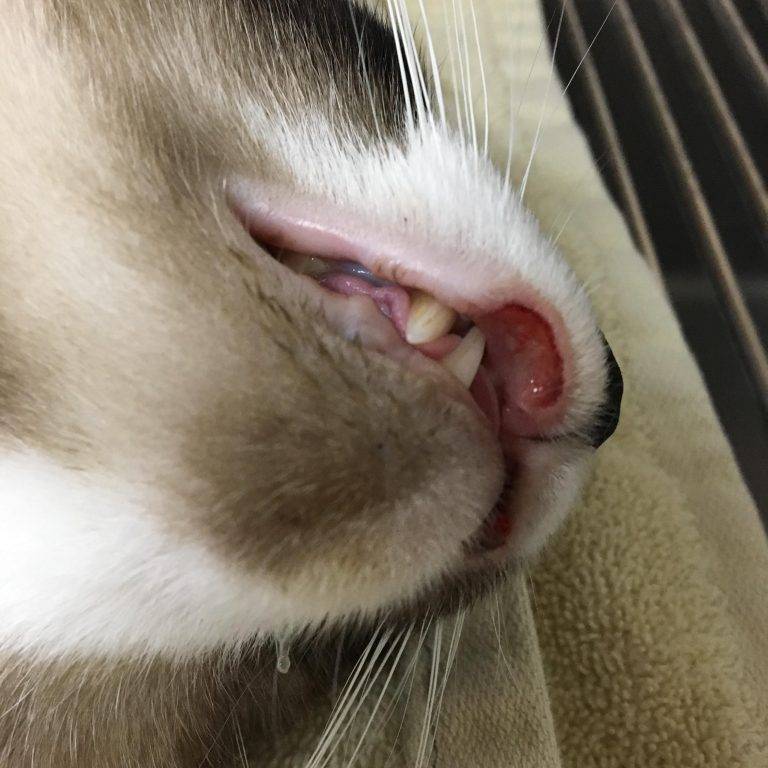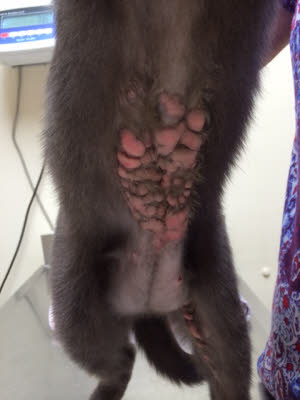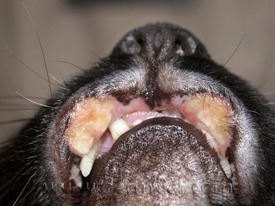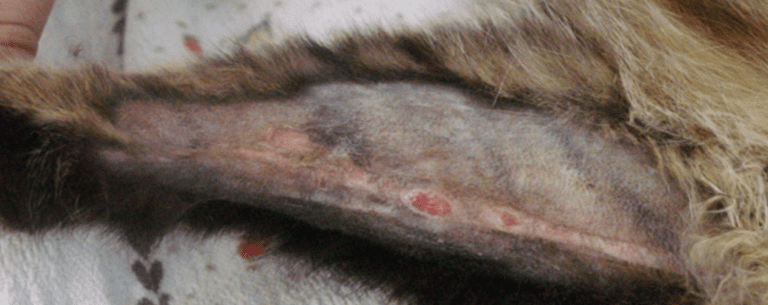A couple of weeks ago I shared a post about eosinophilic pneumonia. Some of you asked me to write about this week’s topics – feline eosinophilic granuloma complex. Ask and ye shall receive! It’s time to spread some more eosinophil love by discussing an important skin condition that affects our feline friends. Happy reading!

What is feline eosinophilic granuloma complex?
Feline eosinophilic granuloma complex is a term used to describe a specific pattern of skin reactions in cats. Other names for this condition include rodent ulcer, feline linear granuloma, feline eosinophilic ulcer, feline collagenolytic granuloma, and cutaneous eosinophilic diseases. The skin reactions are most commonly due to an underlying allergy. This means the skin lesions are not an actual disease but rather a clinical sign of another health issue, most notably:
- Flea allergy
- Environmental allergy
- Food allergy
- Insect hypersensitivity (e.g.: mosquitoes)
Many board-certified veterinary dermatologists believe flea allergy is the most common inciting cause, but other factors like genetics and infectious agents may also play a role.

What does it look like?
The most commonly recognized skin reactions in feline eosinophilic granuloma complex are:
Eosinophilic plaques – Plaques may be singular in nature or multiple lesions may be present. When more than one lesion is present in a localized region, they may coalesce to form a larger one. The lesions are often alopecic (hairless), erythematous (reddened), raised, and eroded. They are quite pruritic (itchy) causing cats to bite and scratch at them, further traumatizing the skin. Common sites for eosinophilic plaques are the abdomen, sides (flanks), and inner thighs.

Indolent ulcers – Also called rodent ulcers, these lesions are found most commonly on the upper lip over a canine tooth (fang tooth). They may also be found inside the mouth. They are usually quite thickened and can be worsened by licking.

Eosinophilic granulomas – These lesions are alopecic (hairless), well-marginated, red-to-orange masses that may be linear in nature. Common sites include the legs, mouth, footpads, face (especially under the chin). The granulomas are frequently crusted or eroded/ulcerated.

How is it diagnosed?
Veterinarians are often able to make a preliminary diagnosis based on the appearance of skin lesions found during a complete physical examination. However, it is important to recognize other skin diseases can produce lesions that appear similarly. Thus, further testing is required to rule them out and definitively diagnose feline eosinophilic granuloma complex, specifically:
- Culture of the skin lesions – to rule the presence of secondary skin infections
- Biopsy of the skin lesions – to document the present of eosinophilic inflammation and rule out other conditions like cancers
Most primary care veterinarians are able to perform the necessary tests to definitively diagnose this condition. If they aren’t, they will recommend partnering with a board-certified veterinary dermatologist.
How is it treated?
Identifying and effectively treating the underlying disease process triggering a cat’s skin lesion is imperative. Systemic therapy with medications given by mouth is the mainstay treatment for feline eosinophilic granuloma complex. Commonly used drugs are those that change the way the immune system responds – so-called immunomodulators. These medications include corticosteroids (e.g.: prednisolone) and cyclosporine.

If a secondary bacterial or fungal infection is documented, an antibiotic or anti-fungal medication, respectively, will also be needed. If a cat is self-traumatizing a lesion with excessive licking and/or scratching, use of an Elizabethan collar (aka the cone of shame) and/or T-shirts can be helpful. Some lesions can be uncomfortable, so pain medication can be helpful. Complimentary interventions, including LASER therapy and acupuncture, may also discussed.
The prognosis for cats with feline eosinophilic granuloma complex is usually excellent if the primary underlying disease is identified and treated. In other words, if a cat has a flea allergy, year-round effective flea control is essential. If this step is not taken, adequate control of the skin lesions will not be possible.
The take-away message about feline eosinophilic granuloma complex…
Feline eosinophilic granuloma complex is the manifestation of specific skin lesions due to underlying disease process, most notably an allergy. Effective treatment involves identification and treatment of the primary disease and medications to induce remission of the skin lesions.
To find a board-certified veterinary dermatologist, please visit the American College of Veterinary Dermatology.
Wishing you wet-nosed kisses,
CriticalCareDVM

Kenneth Andrew Trezise
Excellent summation ! Thanks